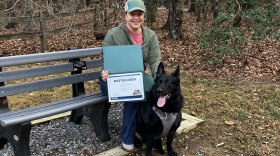Nearly 80 percent of children in families who make less than $50,000 a year have little or no swimming skills. In Central Virginia, groups are working to change those statistics and address the lasting disparities caused by segregation. WCVE’s Ian Stewart has more for Virginia Currents.
Learn More:
Learn more about SwimRVA, and their programs, including Learn to Swim. Find details about Ebony Rosemond's blog Black Kids Swim, which is a resource for African-American swimmers. Read Tamara Copeland's article Swimming in Inequity: Waters Divide.to understand what it was like to grow up in Richmond during segregation.
Transcript:
At the Collegiate School Aquatics Center, second graders are about to get into the pool. Some of them for the very first time. Programs Manager Kris Reinhard has some rules to go over like keeping one hand on the wall for safety.
Kris Reinhard: So what are going to do with one of our hands?
Swimmers: Put 'em on the wall.
Reinhard: What are we going to do?
Swimmers: Put 'em on the wall!
Reinhard: Alright.
The program here is run by SwimRVA, a non-profit that teaches low-income children and children of color how to swim. Citing statistics from both USA Swimming and the Centers for Disease Control, Director Adam Kennedy says roughly half the U.S. population doesn’t know how to swim.
Adam Kennedy: When we break that down, 70 percent of our African-American community doesn’t know how to swim.
Second graders await their turn in the pool. (Photo: Provided by Swim RVA)
Kennedy, along with the Salvation Army Boys & Girls Club, hopes to further reduce that statistic by opening a pool in Church Hill.
Kennedy: This pool will stop the generational reinforcement of non-swimming for African-Americans. This started in segregation, where we said ‘this is for you and this is not for you.’ And it was bad social policy then and we’re still paying the price. And with this pool, we’ll start to create true equity and repair the damage that was done so many years ago.
In segregated Richmond, the only public pool for African-Americans to swim was Brook Field park. The Northside pool closed in 1958, leaving a young Tamara Copeland without this resource.
Tamara Copeland: My parents wanted me to learn to swim, but there really wasn’t a place for the African-American community to swim.
Copeland, now based in D.C., is the author of Daughters of the Dream. In the book, she explores race and civil rights while growing up in the South.
Copeland: You know, the reality is that I didn’t know I couldn’t have swim lessons in other places. I think that my parents, like a lot of other African-American parents, did their very best to protect their children from what they could not do. It was more exposing them to what they could do.
Copeland did get swimming lessons thanks to a black doctor in the neighborhood who opened his pool to the local kids.
Copeland: So it was because of his generosity and the fact that he did have a pool that I was able to learn to swim.
Another Northside resident, Milton Earl Brooks learned how to swim at a young age. His father was a lifeguard at Brook Field pool until the city shut it down. Officials said it needed major repairs. But residents were skeptical. It was the only public pool open in the entire city.
This didn’t deter Brooks from swimming. When he got older, he wanted to become a lifeguard like his father. But he ran into a problem when he needed to get his certification.
Milton Brooks: The only place that was giving Red Cross exams was the downtown YMCA. They were going to put a lot of obstacles in my way, to joining the class.
During segregation only whites were allowed to swim in public pools. This is the underground pool at downtown YMCA. (Photo: Cook Studio/Courtesy the Valentine Museum)
Brooks said they needed three letters attesting to his civility.
Brooks: And I was a good upstanding citizen to be able to join the Y.
Brooks knew just the right people to ask. One was his Uncle. Then he reached out to Doug Wilder, who was a lawyer before being elected to the Virginia State Senate. Brooks also asked City Councilman William “Fergie” Reed, who later was the first African-American elected to the Virginia Assembly since Reconstruction.
Brooks: They couldn’t complain about those three gentleman.
Brooks got his certification and later taught swimming at the Boy’s Club in Church Hill. This location is the site of a brand new pool where SwimRVA will give lessons.
Debbie Kelo: You know, there are barriers to access.
Debbie Kelo is SwimRVA’s Director of Programming.
Kelo: So that’s what we’re trying to do with this program -- the learn to swim program -- is it’s a free program. It doesn’t cost the schools or the families anything.
Their learn to swim program started in the 1990s. If needed they provide swimsuits and towels. Kelo says sometimes children cry before getting into the water. But after seven weeks…
Kelo: They’re putting their face in the water, able to blow their bubbles. They’re starting to work on how to float. So it is very rewarding to see them smile and be happy.
SwimRVA partners with 136 Richmond area elementary schools in Chesterfield, Hopewell, Mechanicsville and Petersburg. Their goal is to go out as far as Louisa and Caroline County.
There are other free programs around Richmond, including one put on by the City’s Parks and Rec.
While there are strides being made locally in teaching African-American second graders how to swim, when it comes to competitive swimming nationally, the numbers show a stark contrast, says Ebony Rosemond. She says USA Swimming has about 300,000 swimmers nationwide.
Ebony Rosemond: Less than 1.4 percent of their membership identifies as African-American.
To combat that low number, Rosemond launched a non-profit web resource called Black Kids Swim. She says it’s not a swim team or a club.
Rosemond: What we do is try to get kids into the sport and support those kids who are already in the sport.
Based in Maryland, Black Kids Swim holds swim fairs and skills camp to increase participation in the sport. Part of their mission is to also break the cycle of stereotypes, such as how African-Americans don’t want to get their hair wet.
Rosemond: And it’s completely unacceptable that a stereotype or a hairdo should be a reason why are kids are losing their lives.
Instructor Patricia Irvin teaches her student how to dunk and hold his breath. (Photo: Ian Stewart/WCVE)
One of SwimRVA’s instructors is Patricia Irvin. Irvin, who is African-American, grew up in New York swimming or as she says “just paddling” in a pool across from her house. Now 72, she’s been coaching here for the last year.
Patricia Irvin: I consider myself to be a helper, assistant.
She says she doesn’t see herself as a role-model for African-American children who are just starting to swim. Instead, they’re focused on the basics.
Irvin: They’re just thinking about drinking -- taking in too much water in their mouths, and drowning, something like that, you know.
Irvin says the best part comes when the course is finished because the children are excited.
Irvin: And then all of the sudden they come running to you and want to hug you. And that’s their way of thanking you.
SwimRVA is making progress with elementary school students, but there are limited options for teens within area schools that lack pools. Chesterfield and Henrico partner with local pools for their teams. Richmond Public Schools have no high school teams, but one student diver trains with Maggie Walker students. RPS is considering expanding its partnership with SwimRVA to offer programs to middle and high school students.
For Virginia Currents, I’m Ian Stewart.















